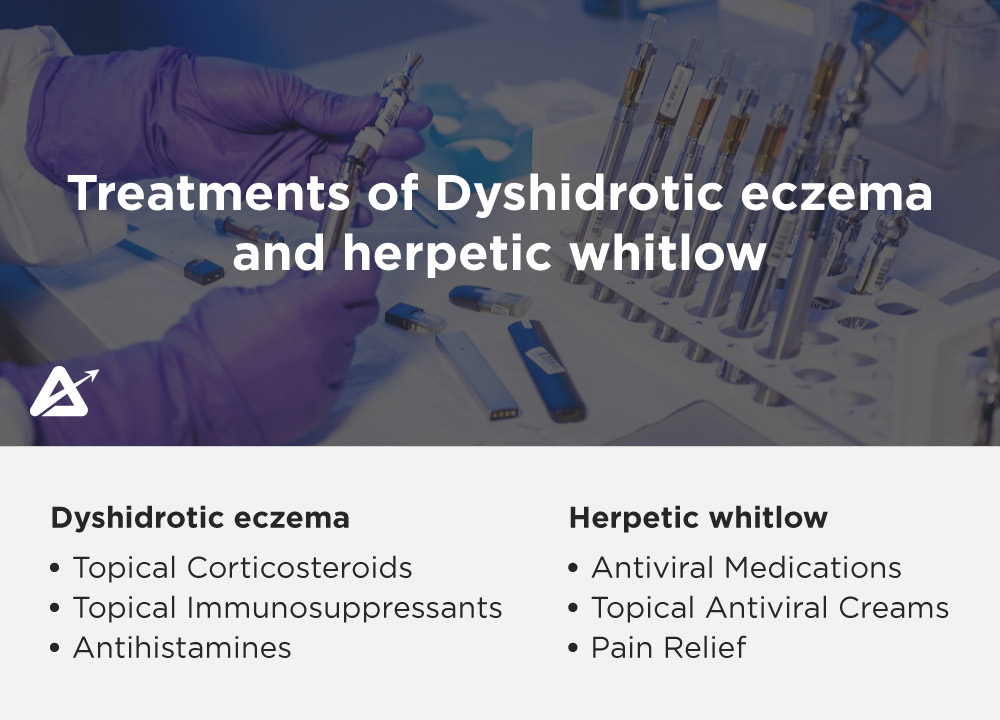Dyshidrotic eczema and herpetic whitlow are dermatological conditions that can cause discomfort and confusion due to similar symptoms. We are anam cara. In this blog, we will explore the key differences between these conditions, helping you understand their causes, symptoms, and treatment options. Stay tuned for a clear understanding of Dyshidrotic eczema and herpetic whitlow.
Dyshidrotic eczema and herpetic whitlow: Definition
Dyshidrotic eczema:
It, also known as dyshidrosis or pompholyx, is a type of eczema characterized by small, itchy blisters that develop on the palms of the hands, fingers, and sometimes the soles of the feet. The cause of dyshidrotic eczema is not fully understood. But it is believed to be related to factors such as allergies, stress, and exposure to certain irritants. The condition can be chronic and recurrent, with flare-ups that may be triggered by environmental or internal factors. Treatments for dyshidrotic eczema include topical corticosteroids, antihistamines, and emollients to soothe the skin.
Herpetic whitlow:
Herpetic whitlow, on the other hand, is a viral infection caused by the herpes simplex virus (HSV) and typically affects the fingers or thumbs. It is commonly contracted through direct contact with an active herpes lesion, such as a cold sore or genital herpes blister. The infection manifests as painful, fluid-filled blisters that can break open and form ulcers. Herpetic whitlow is highly contagious, and appropriate precautions should be taken to prevent its spread. Antiviral medications can help alleviate symptoms and reduce the duration of outbreaks.
While both conditions affect the skin and present with blister-like lesions, they differ in their underlying causes and treatments. Dyshidrotic eczema is primarily an inflammatory skin condition, while herpetic whitlow is a viral infection. Consulting a healthcare professional is recommended for accurate diagnosis and appropriate management of these conditions.
what is the difference between dyshidrotic eczema vs herpetic whitlow?

Dyshidrotic eczema and herpetic whitlow are two distinct conditions with different causes and characteristics. Here are the key differences between the two:
| Dyshidrotic eczema | Herpetic whitlow |
| Cause: Dyshidrotic eczema is believed to be caused by various factors, including allergies, stress, and exposure to irritants. | On the other hand, herpetic whitlow is caused by the herpes simplex virus (HSV), typically HSV-1 or HSV-2. |
| Symptoms: Dyshidrotic eczema manifests as small, itchy blisters on the hands and feet. The blisters may be accompanied by redness, scaling, and dryness of the skin. | Herpetic whitlow, however, presents as painful, fluid-filled blisters that appear on the fingers or around the nails. These blisters may be accompanied by a burning sensation or tingling. |
| Contagiousness: Dyshidrotic eczema is not contagious and cannot be spread from person to person. | Herpetic whitlow, on the other hand, is highly contagious and can be transmitted through direct contact with the infected blisters or fluid. |
| Treatment: Dyshidrotic eczema can be managed with moisturizers, corticosteroid creams, and avoiding triggers. | Herpetic whitlow usually requires antiviral medications to control the infection and reduce symptoms |
It is crucial to consult a healthcare professional for an accurate diagnosis and appropriate treatment, as these conditions have distinct causes and management strategies.
Dyshidrotic eczema and herpetic whitlow: Causes
Both are two distinct skin conditions that can cause similar symptoms but have different underlying causes.
Dyshidrotic eczema :
It, also known as dyshidrosis or pompholyx, is a type of eczema that primarily affects the hands and feet. The exact cause of dyshidrotic eczema is unknown, but it is believed to be triggered by various factors, including allergies, stress, exposure to certain substances or metals, and abnormal sweating. It is characterized by the formation of small, itchy blisters on the skin, which can be accompanied by redness and peeling.
Herpetic whitlow:
On the other hand, herpetic whitlow is a viral infection caused by the herpes simplex virus (HSV). It typically affects the fingers or thumbs and is commonly seen in healthcare workers or individuals with frequent exposure to HSV. Herpetic whitlow can occur when the virus enters the skin through a break or cut, leading to the development of painful blisters or ulcers.
While dyshidrotic eczema is primarily associated with eczema-related triggers, herpetic whitlow is caused by the herpes simplex virus and is contagious. Differentiating between the two conditions is crucial for appropriate treatment and management. Therefore, consulting a healthcare professional for an accurate diagnosis is recommended.
Symptoms of Dyshidrotic eczema and herpetic whitlow:
Dyshidrotic eczema and herpetic whitlow are two distinct conditions that affect the skin, each with its own set of symptoms.
Dyshidrotic eczema, also known as dyshidrosis or pompholyx, is a type of eczema characterized by small, itchy blisters that typically appear on the palms of the hands, soles of the feet, or sides of the fingers. These blisters can be filled with clear fluid and may cause redness, swelling, and a burning or tingling sensation. In severe cases, the blisters may become large and cause pain or lead to skin cracking and peeling.
Herpetic whitlow, on the other hand, is a viral infection caused by the herpes simplex virus (HSV). It primarily affects the fingers or thumb, resulting in painful, red, and swollen lesions or blisters filled with clear or yellowish fluid. Additional symptoms may include itching, tingling, or a burning sensation in the affected area. Herpetic whitlow can be accompanied by fever, fatigue, and swollen lymph nodes in some cases.
Both conditions require medical attention for proper diagnosis and treatment. Dyshidrotic eczema may be managed with topical corticosteroids, antihistamines, or emollients, while herpetic whitlow usually necessitates antiviral medications to reduce the severity and duration of the infection.
Treatments of Dyshidrotic eczema and herpetic whitlow :

Dyshidrotic eczema and herpetic whitlow are two different conditions that affect the skin. Let’s discuss the treatments for each condition separately:
Dyshidrotic Eczema:
Dyshidrotic eczema, also known as pompholyx, is a form of eczema characterized by small, itchy blisters on the hands and feet. The treatment options for dyshidrotic eczema include:
- Topical Corticosteroids: These are commonly prescribed to reduce inflammation and relieve itching. Mild to moderate corticosteroid creams or ointments can be applied to the affected areas.
- Topical Immunosuppressants: Tacrolimus ointment or pimecrolimus cream may be prescribed when corticosteroids are not effective or not suitable for long-term use.
- Antihistamines: Oral antihistamines like cetirizine or loratadine can help relieve itching.
- Wet Compresses: Applying wet compresses or soaking the affected hands or feet in cool water can help reduce inflammation and provide relief.
- Moisturizers: Regularly applying moisturizers, especially after bathing or washing hands, can help prevent dryness and maintain skin hydration.
- Avoiding Triggers: Identifying and avoiding triggers that worsen the condition, such as certain allergens, irritants, or excessive sweating, can help prevent flare-ups.
It is important to consult with a healthcare professional or dermatologist for an accurate diagnosis and appropriate treatment plan.
Herpetic Whitlow:
Herpetic whitlow is a viral infection caused by the herpes simplex virus (HSV) and typically affects the fingers or thumbs. The treatment options for herpetic whitlow include:
- Antiviral Medications: Oral antiviral medications like acyclovir, valacyclovir, or famciclovir are commonly prescribed to reduce the severity and duration of the infection. These medications work by suppressing the replication of the herpes virus.
- Topical Antiviral Creams: In some cases, topical antiviral creams like acyclovir or penciclovir may be recommended to be applied directly to the affected area.
- Pain Relief: Over-the-counter pain relievers like acetaminophen or ibuprofen can help alleviate pain and discomfort associated with herpetic whitlow.
It is crucial to consult a healthcare professional or a healthcare provider specializing in infectious diseases for proper diagnosis and appropriate treatment. They may also provide guidance on preventing the spread of the infection to other areas or individuals.
Is dyshidrotic eczema the same as herpes Whitlow?
No, dyshidrotic eczema and herpes whitlow are not the same conditions. Dyshidrotic eczema, also known as dyshidrosis or pompholyx, is a skin disorder characterized by small, itchy blisters that typically appear on the hands and feet. The exact cause is unknown, but it is believed to be related to allergies, stress, or certain irritants.
On the other hand, herpes whitlow is a viral infection caused by the herpes simplex virus (HSV) and primarily affects the fingers and hands. It usually results from direct contact with the virus, such as through an oral or genital herpes infection. Herpes whitlow causes painful, fluid-filled blisters that can be accompanied by flu-like symptoms.
While both conditions may present with blisters on the hands, they have distinct causes. Dyshidrotic eczema is associated with eczema and allergic reactions, whereas herpes whitlow is caused by the herpes virus. A proper diagnosis from a healthcare professional is essential to differentiate between the two and determine the appropriate treatment.
In conclusion
Distinguishing between Dyshidrotic eczema and herpetic whitlow can be challenging due to their similar symptoms, such as blisters and itching. However, several key differences can help differentiate the two conditions. Dyshidrotic eczema is often triggered by allergies or stress, while herpetic whitlow is caused by the herpes simplex virus. Medical examination, history, and diagnostic tests are essential for accurate diagnosis and appropriate treatment of these distinct conditions.






